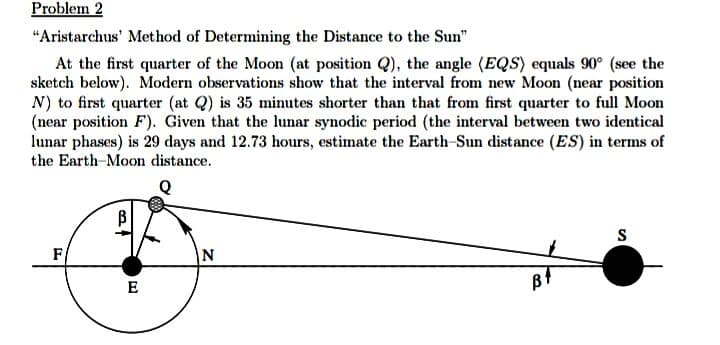"Aristarchus' Method of Determining the Distance to the Sun" At the first quarter of the Moon (at position Q), the angle (EQS) equals 90° (see the sketch below). Modern observations show that the interval from new Moon (near position N) to first quarter (at Q) is 35 minutes shorter than that from first quarter to full Moon (near position F). Given that the lunar synodic period (the interval between two identical lunar phases) is 29 days and 12.73 hours, estimate the Earth-Sun distance (ES) in terms of the Earth-Moon distance. F/ E
"Aristarchus' Method of Determining the Distance to the Sun" At the first quarter of the Moon (at position Q), the angle (EQS) equals 90° (see the sketch below). Modern observations show that the interval from new Moon (near position N) to first quarter (at Q) is 35 minutes shorter than that from first quarter to full Moon (near position F). Given that the lunar synodic period (the interval between two identical lunar phases) is 29 days and 12.73 hours, estimate the Earth-Sun distance (ES) in terms of the Earth-Moon distance. F/ E
Related questions
Question
100%

Transcribed Image Text:"Aristarchus' Method of Determining the Distance to the Sun"
At the first quarter of the Moon (at position Q), the angle (EQS) equals 90° (see the
sketch below). Modern observations show that the interval from new Moon (near position
N) to first quarter (at Q) is 35 minutes shorter than that from first quarter to full Moon
(near position F). Given that the lunar synodic period (the interval between two identical
lunar phases) is 29 days and 12.73 hours, estimate the Earth-Sun distance (ES) in terms of
the Earth-Moon distance.
F/
E
Expert Solution
This question has been solved!
Explore an expertly crafted, step-by-step solution for a thorough understanding of key concepts.
This is a popular solution!
Trending now
This is a popular solution!
Step by step
Solved in 6 steps with 6 images
